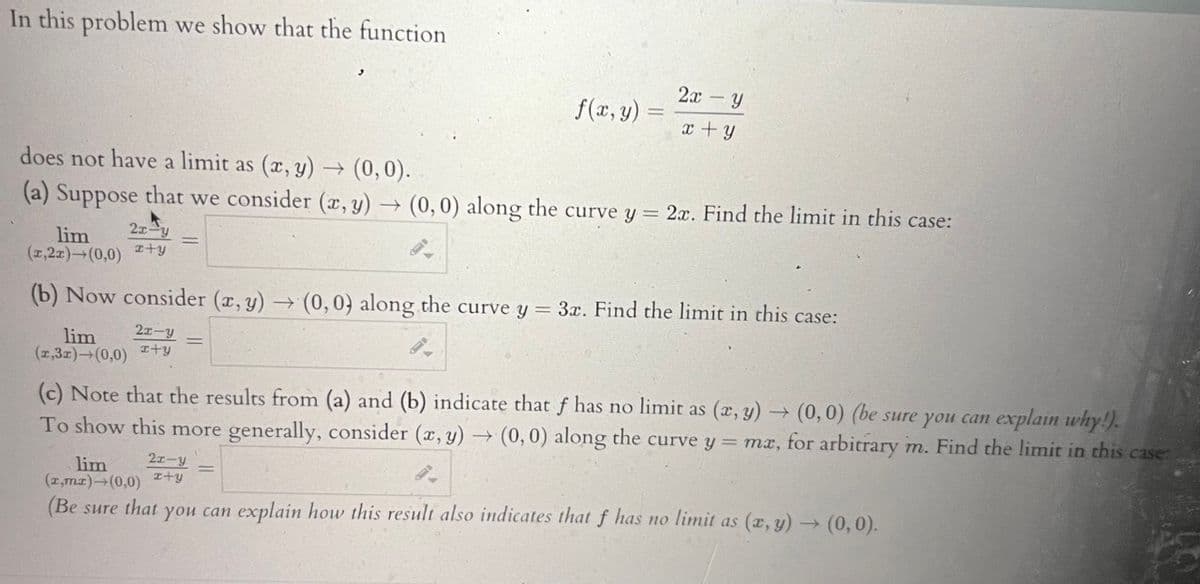In this problem we show that the function f(x, y) = 21-y lim (1,2x) (0,0) I+y 2x - Y x + y does not have a limit as (x, y) → (0,0). (a) Suppose that we consider (x, y) → (0,0) along the curve y = 2x. Find the limit in this case: (b) Now consider (x, y) (0,0) along the curve y = 3x. Find the limit in this case: lim 2x-y (2,3x) (0,0) +y (c) Note that the results from (a) and (b) indicate that f has no limit as (x,y) → (0,0) (be sure you can explain why!). To show this more generally, consider (x,y) → (0,0) along the curve y = mx, for arbitrary m. Find the limit in this case: lim 2x-y (z,mz)→(0,0) x+y (Be sure that you can explain how this result also indicates that f has no limit as (x,y) → (0,0).
In this problem we show that the function f(x, y) = 21-y lim (1,2x) (0,0) I+y 2x - Y x + y does not have a limit as (x, y) → (0,0). (a) Suppose that we consider (x, y) → (0,0) along the curve y = 2x. Find the limit in this case: (b) Now consider (x, y) (0,0) along the curve y = 3x. Find the limit in this case: lim 2x-y (2,3x) (0,0) +y (c) Note that the results from (a) and (b) indicate that f has no limit as (x,y) → (0,0) (be sure you can explain why!). To show this more generally, consider (x,y) → (0,0) along the curve y = mx, for arbitrary m. Find the limit in this case: lim 2x-y (z,mz)→(0,0) x+y (Be sure that you can explain how this result also indicates that f has no limit as (x,y) → (0,0).
Advanced Engineering Mathematics
10th Edition
ISBN:9780470458365
Author:Erwin Kreyszig
Publisher:Erwin Kreyszig
Chapter2: Second-order Linear Odes
Section: Chapter Questions
Problem 1RQ
Related questions
Question
Please answer full question. 3 numbers, but all part of same question. Will upvote

Transcribed Image Text:In this problem we show that the function
f(x, y)
2x - Y
x + y
does not have a limit as (x, y) → (0,0).
(a) Suppose that we consider (x, y) → (0,0) along the curve y = 2x. Find the limit in this case:
2x-y
lim
(1,2x) (0,0) +y
(b) Now consider (x,y) → (0,0) along the curve y = 3x. Find the limit in this case:
2x-y
lim
(1,31) (0,0) +y
2x-y
x+y
(c) Note that the results from (a) and (b) indicate that f has no limit as (x,y) → (0,0) (be sure you can explain why!).
To show this more generally, consider (x, y) → (0,0) along the curve y = mx, for arbitrary m. Find the limit in this case:
lim
(x,mx)→(0,0)
(Be sure that you can explain how this result also indicates that f has no limit as (x,y) → (0,0).
Expert Solution
This question has been solved!
Explore an expertly crafted, step-by-step solution for a thorough understanding of key concepts.
This is a popular solution!
Trending now
This is a popular solution!
Step by step
Solved in 2 steps with 2 images

Recommended textbooks for you

Advanced Engineering Mathematics
Advanced Math
ISBN:
9780470458365
Author:
Erwin Kreyszig
Publisher:
Wiley, John & Sons, Incorporated

Numerical Methods for Engineers
Advanced Math
ISBN:
9780073397924
Author:
Steven C. Chapra Dr., Raymond P. Canale
Publisher:
McGraw-Hill Education

Introductory Mathematics for Engineering Applicat…
Advanced Math
ISBN:
9781118141809
Author:
Nathan Klingbeil
Publisher:
WILEY

Advanced Engineering Mathematics
Advanced Math
ISBN:
9780470458365
Author:
Erwin Kreyszig
Publisher:
Wiley, John & Sons, Incorporated

Numerical Methods for Engineers
Advanced Math
ISBN:
9780073397924
Author:
Steven C. Chapra Dr., Raymond P. Canale
Publisher:
McGraw-Hill Education

Introductory Mathematics for Engineering Applicat…
Advanced Math
ISBN:
9781118141809
Author:
Nathan Klingbeil
Publisher:
WILEY

Mathematics For Machine Technology
Advanced Math
ISBN:
9781337798310
Author:
Peterson, John.
Publisher:
Cengage Learning,

